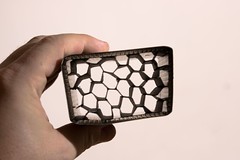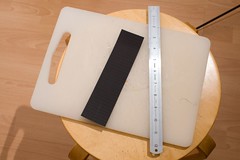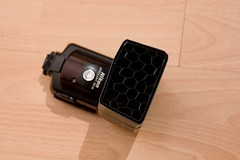 So far, for making grids, I have used drinking straws and coroplast. The straws have been the most successful so far, but I wanted to consider other methods, as neither the straws, nor the coroplast, have been particularly scaleable. So I had a go at making honeycomb grids.
So far, for making grids, I have used drinking straws and coroplast. The straws have been the most successful so far, but I wanted to consider other methods, as neither the straws, nor the coroplast, have been particularly scaleable. So I had a go at making honeycomb grids. All you need is some black card and glue, or double sided sticky tape. First decide how big you want your holes to be. If you are covering a large area, you might want to have big holes, as the bigger the hole the less work you have to do to construct it. For a smaller area you might want smaller holes. This construction method allows you to make grids with any sized hole you like. Bigger holes will let through more light, but they will also allow the light to escape over a wider angle, so if you make your hole bigger you will need to make your grid deeper to restrict the light.
 For a small grid, I chose a create the honeycombs a quarter of an inch long on each side of the hexagon. This makes the widest part of the hexagon approximately three eights of an inch wide. To keep the beam tight, I made the grid two inches deep. One A4 sheet of paper was enough to make the grid with plenty to spare.
For a small grid, I chose a create the honeycombs a quarter of an inch long on each side of the hexagon. This makes the widest part of the hexagon approximately three eights of an inch wide. To keep the beam tight, I made the grid two inches deep. One A4 sheet of paper was enough to make the grid with plenty to spare.
The first step is to draw lines a quarter of an inch apart with a ballpoint pen, parallel to the shortest side of the paper. Press hard enough to score the paper and make it easy to bend. Take care not to press so hard that it makes the paper tear. Then cut the paper into 2 inch strips, parallel to the longest side.
 Next you need to bend the paper into into honeycomb halves. Its basically two bends in one direction and two in the other, repeat until you have a nicely corrugated sheet of paper. Cut the paper in half, down the middle and match up the corrugations so that you have the beginnings of a honeycomb. You can use glue or double sided sticky tape to glue the adjoining faces together, I like the sticky tape because it is less messy. Rinse and repeat until you have made it big enough to fit in front of your flash head.
Next you need to bend the paper into into honeycomb halves. Its basically two bends in one direction and two in the other, repeat until you have a nicely corrugated sheet of paper. Cut the paper in half, down the middle and match up the corrugations so that you have the beginnings of a honeycomb. You can use glue or double sided sticky tape to glue the adjoining faces together, I like the sticky tape because it is less messy. Rinse and repeat until you have made it big enough to fit in front of your flash head.
 Finally, you will need to attach it to the flash I cut some coroplast to fit round the flash, and stuck the honeycomb inside it with doublesided tape. I then wrapped it in gaffer tape.
Finally, you will need to attach it to the flash I cut some coroplast to fit round the flash, and stuck the honeycomb inside it with doublesided tape. I then wrapped it in gaffer tape.
If you have something big you want to grid, you can make a big honeycomb, I built one for my 24cm gridspot, but with hindsight I should have made the grid a lot deeper to restrct the beam more. One day I will make a huge one to fit on an umbrella, just you wait and see.
 The small honeycomb grid performs about as well as the straw snoot. I think the light output is slightly stronger and the spot is slightly hexagonal compared to the circular spot produced by the straw grid. I found that the hexagonal grid was easier to construct than a straw grid and the parts more readily available. I also prefer the hexagonal spot to the square spot that the coroplast grid produced, but the coroplast snoot was much easier to construct.
The small honeycomb grid performs about as well as the straw snoot. I think the light output is slightly stronger and the spot is slightly hexagonal compared to the circular spot produced by the straw grid. I found that the hexagonal grid was easier to construct than a straw grid and the parts more readily available. I also prefer the hexagonal spot to the square spot that the coroplast grid produced, but the coroplast snoot was much easier to construct.
Where the honeycomb construction method really wins, is when you want to cover a large area. Its much easer to put together a big grid with a honeycomb than using straws or coroplast. But if you absolutely must have a circular spot, then you should use straws.



Nice one, do you know if the lighting result between a honeycomb or just square holes would be different?
ReplyDeletethanks,
Richard
---
www.urban-exploring.com
Square holes will give a slightly squarer spot. If you look at this post , you will see what it might look like in the first image
ReplyDeleteJust love your idea. Lets unstraw the grid.
ReplyDeleteThis really gives you much more control over the size of the grid.
- udi
Thanks Paulo! I need to take some photos of my beautiful pregnant wife's belly and I was looking for a DIY honeycomb for backlights.
ReplyDeletei want to make machine of honey comb paper making can anyone help me?
ReplyDeleteif anybody want to contact me then please contact me on jilan.sakaria@gmail.com